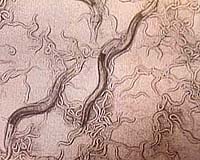| . |  |
. |
Cambridge, England (UPI) Aug 5, 2009 One tiny change in DNA could lead to the evolution of a new species, an English researcher reported. A team lead by a University of Cambridge scientist explored this possibility when they studied two closely related flycatcher populations in the Solomon Islands, reporting their results in the American Naturalists. The scientists said they studied two sub-species with the same body shape, but different colored bellies and distinct songs. Birds from these sub-species could mate, but sub-species' differences prevented them from recognizing each other as potential sexual partners. Researchers said the ability to mate but the lack of recognition indicated the beginning of the evolution of new species. Other flycatchers in the Solomon Islands, east of Papua New Guinea, also differed in plumage color, but the genetic basis is not always as clear as a single DNA mutation, researchers said. Rebecca Kilner of Britain's University of Cambridge said the study indicates how a single gene can cause color change in birds, affecting the selection of potential sexual partners. Research indicated the DNA change could lead to reproductive isolation and eventually speciation, she said, but "in ways that are more complex than previously appreciated." Share This Article With Planet Earth
Related Links Explore The Early Earth at TerraDaily.com
 Giant marine worms lived 475 million years ago: scientists
Giant marine worms lived 475 million years ago: scientistsCabaneros National Park, Spain (AFP) Aug 3, 2009 Spanish researchers said Monday they have discovered evidence of a type of giant worm that lived 475 million years ago and was up to one metre (three feet) in length. The fossilised tracks of the marine worms were found in the Cabaneros National Park in central Spain in an area that was a seabed during the Lower Ordovician period, the Spanish National Research Council (CSIC) said. ... read more |
|
| The content herein, unless otherwise known to be public domain, are Copyright 1995-2009 - SpaceDaily. AFP and UPI Wire Stories are copyright Agence France-Presse and United Press International. ESA Portal Reports are copyright European Space Agency. All NASA sourced material is public domain. Additional copyrights may apply in whole or part to other bona fide parties. Advertising does not imply endorsement,agreement or approval of any opinions, statements or information provided by SpaceDaily on any Web page published or hosted by SpaceDaily. Privacy Statement |